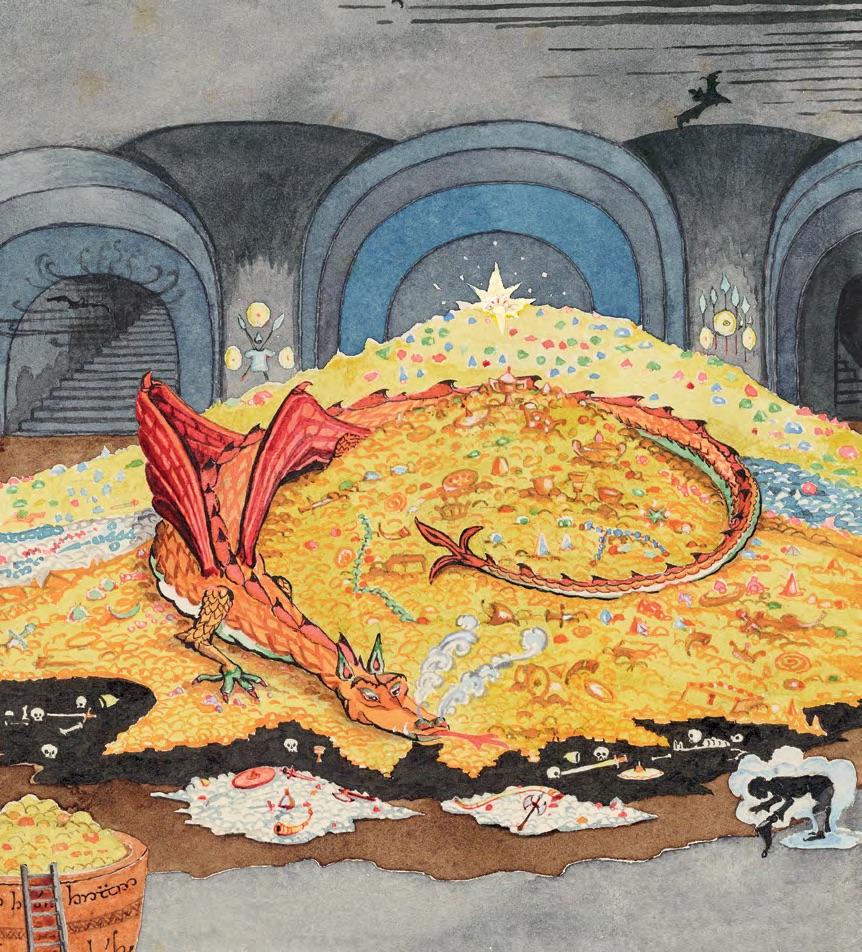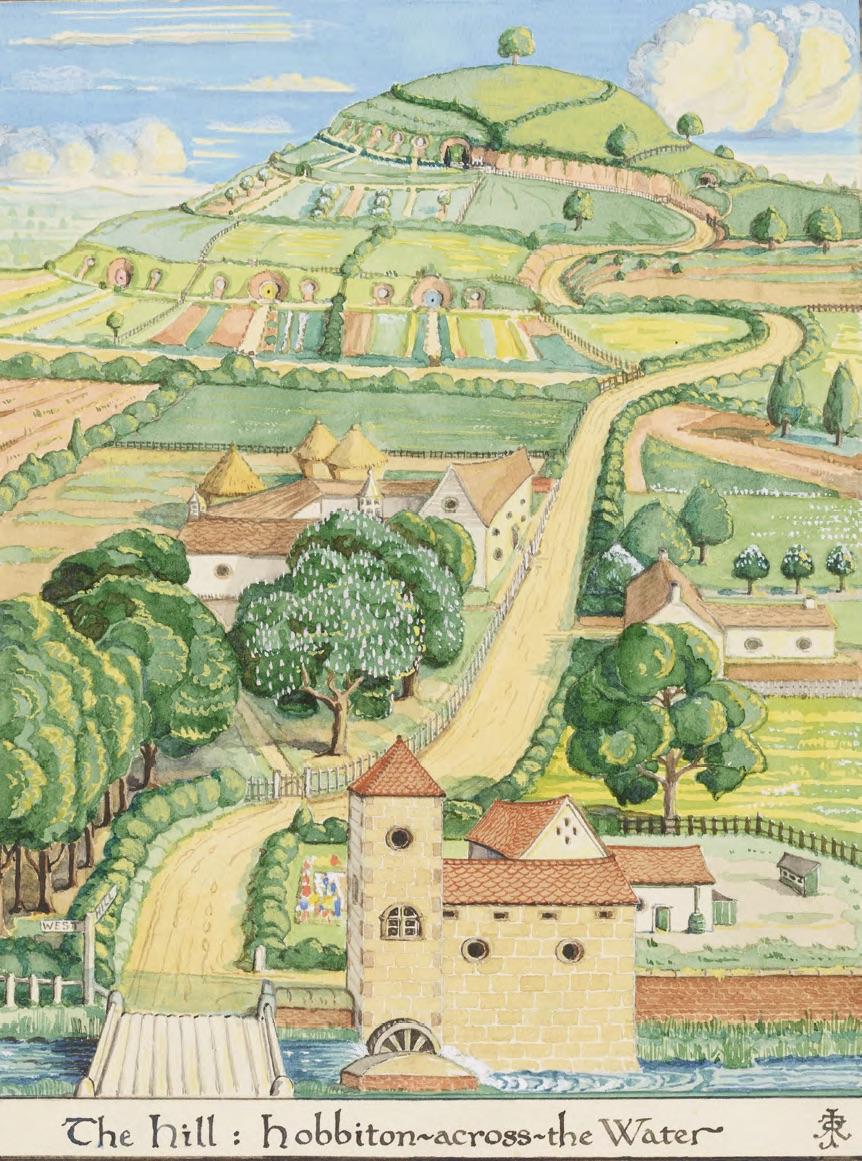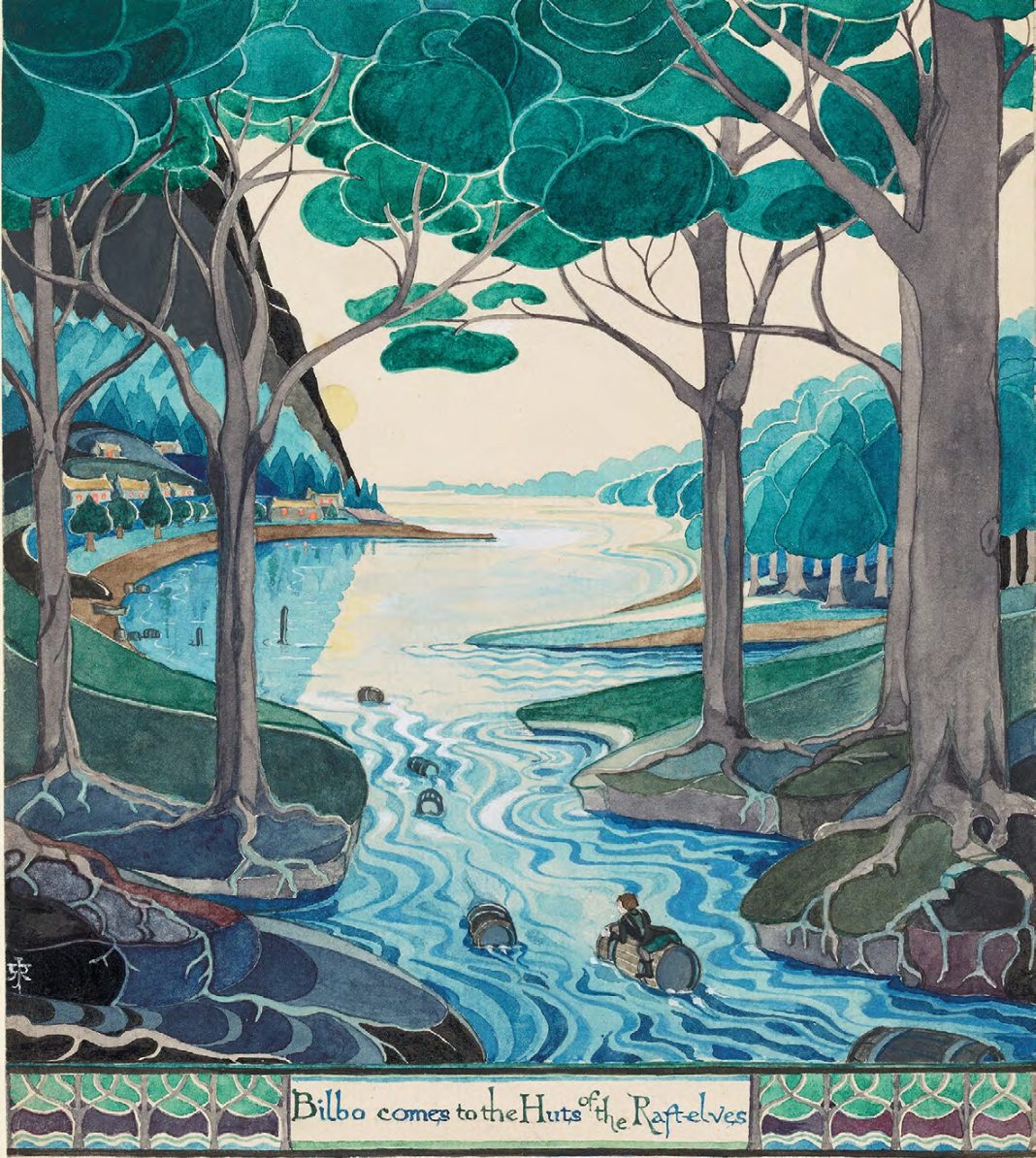All images © The Tolkien Estate Limited 1937.
Tne moment, I was walking through the steel-and-concrete labyrinth of New York City. The next, I had entered the Morgan Library, taken its glass elevator to the second floor, and walked into Middle Earth. Or rather, into the art and imagination of J.R.R. Tolkien, which is as magical as Rivendell or the forest of Lothlorien itself. If you had accompanied me to the exhibit Tolkien: Maker of Middle Earth, you could have seen photographs of Tolkien as a child and then a student, and finally in military uniform, as well as artifacts from his life, such as his paint box and academic robes, and manuscripts in his distinctive curling, tendril-like handwriting, which looked magically Elvish even when he was writing a letter to his children. But most of all, you would have seen his paintings: watercolors in jewel tones, clearly influenced both by his love of nature and the artistic movement known as Art Nouveau, whose sinuous shapes were inspired by elements of the natural world.
The young John Ronald Reuel grew up at a time when ladies and gentlemen were taught to draw and paint as part of their education. Even as a child, he was a skillful watercolorist, as shown by his painting of a tree hanging over a stream from around 1906, when he was only fourteen. It is not yet in his distinctive style but displays the sensitivity to natural forms and colors that would be evident in his later work.

His distinctive style begins to appear in a book of accounts he kept during his university days, which documents how much he studied—each hour to be rewarded by a kiss from Edith Bratt, who would become his wife. The carefully formed letters and numbers already point toward the elegant calligraphy of Elvish. We see it again in The Garden of the Merking’s Palace, painted in 1927, where those calligraphic flourishes have become tendrils and fronds, curling upward in an underwater landscape of pinks and blues and greens, while a curious fish stares at us, wondering what we are doing at the bottom of the sea. Those curling natural shapes appear everywhere in Tolkien’s art, from the intricate designs he doodled on newspapers after completing a crossword puzzle to the script on magnificent hand-drawn maps he made to plot journeys across the landscape of Middle Earth. But the jewels of the exhibit, and Tolkien’s masterpieces, were of course his sketches and illustrations for The Hobbit, The Lord of the Rings, and The Silmarillion. Those are also the works most clearly influenced by Art Nouveau.
In one illustration from The Hobbit, a yellow road winds between pleasant fields and houses to the hillside home where the Bagginses have lived since time out of mind, behind a bright green door. In another, an illustration of Bilbo’s cleverly engineered escape from the Wood-Elves, he and the company of dwarves ride barrels down a river of blue curlicues,
while slender trees tower overhead, their leaves resembling green clouds. In one of Tolkien’s most famous illustrations, Conversation With Smaug, the orange dragon coils on his hoard like the figure on a vase by Émile Gallé. The most beautiful work in the exhibit, a pencil sketch titled The Forest of Lothlorien in Spring, shows the mallorn trees of that forest, with their silver trunks and golden flowers.

Trees were important to Tolkien, both in themselves and for what they represented. Throughout his life, there was one tree he drew over and over again, with a curving trunk from whose branches grew leaves and flowers of various sorts, no two alike. He called it the Tree of Amalion, but we could also call it the Tree of Tales, because it represents the infinite variety of storytelling itself. This shape was associated in Tolkien’s mind with magic and myth-making, which are, in a sense, the same activity. It is no wonder that in Peter Jackson’s The Lord of the Rings film trilogy, the props associated with Elves were based on the natural shapes of
Art Nouveau.
But why Art Nouveau? After all, that artistic movement was strongest at the turn of the century, when it had influenced not only painting but the architecture of Hector Guimard, the posters of Alphonse Mucha, the lamps of Louis Comfort Tiffany, and the jewelry of René Lalique. By the time The Hobbit was published in 1937, artistic taste had turned to the sleek, modern style of Art Deco, which has given us much of the New York skyline. Indeed, in the film trilogy, the props associated with dwarves, those master manufacturers, were based in part on Art Deco. But an artistic style inspired by the machine age would not have been appropriate for Tolkien’s Elves, who are guardians of the natural world.
One of the most important aspects of Tolkien’s writing is his environmentalism, his belief that we clumsy humans, who scare away hobbits with our loud footsteps, need nature: We need forests and streams and mountains. His artistic style is an expression of that philosophy, which seems more relevant today than ever. In a world where machines seem to be taking over, we long for Rivendell and Lothlorien. Tolkien’s art offers us not only an escape from modernity but a possible reformulation of it. It tells us that in our busy modern lives, we need to make space for trees and flowers, art and the imagination.



































